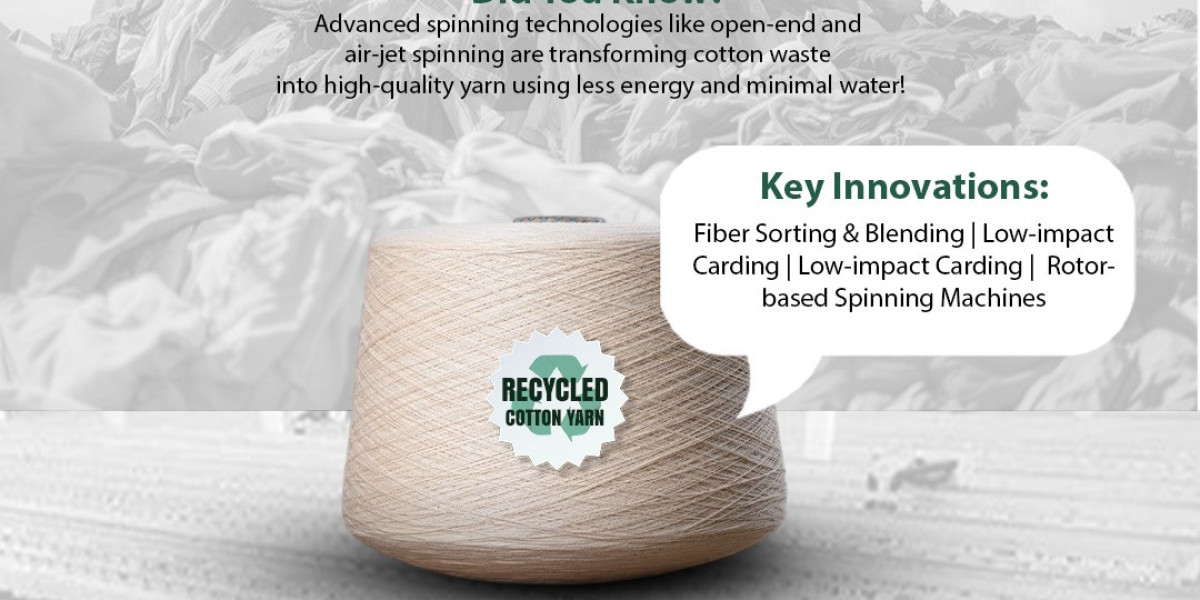In recent years, the fashion industry has faced growing scrutiny for its environmental footprint. From water pollution to textile waste, the industry’s rapid production cycles have left a lasting impact on the planet. However, a quiet revolution is taking place — one led by recycled yarn manufacturers who are reshaping the way fabrics are made. The future of fashion, it seems, lies not in creating more, but in creating smarter — and recycled yarn is at the heart of this transformation.
Understanding Recycled Yarn
Recycled yarn is produced from pre-consumer or post-consumer textile waste, including fabric scraps, used garments, or even PET plastic bottles. Instead of letting these materials end up in landfills, recycling processes give them a second life as new, usable yarn.
The production of recycled yarn typically follows two main methods:
Mechanical Recycling:
Textiles are shredded into fibers and spun into yarn without the use of harsh chemicals.Chemical Recycling:
Fibers are broken down chemically and reformed into new yarn, often used for synthetic fibers like polyester.
Both processes contribute to reducing waste and conserving resources, offering a sustainable alternative to conventional yarn production.
The Fast Fashion Problem
Fast fashion has changed how we buy and wear clothes. Today’s consumers often buy inexpensive, trendy garments that are discarded after just a few uses. The result? Over 92 million tons of textile waste are generated every year globally.
Traditional fabric manufacturing uses massive amounts of water, energy, and raw materials. For instance:
Producing 1 kg of virgin cotton yarn can consume up to 20,000 liters of water.
Dyeing and finishing fabrics contribute to around 20% of the world’s industrial water pollution.
In this context, recycled yarn suppliers offer a much-needed solution — turning waste into resource while dramatically reducing environmental impact.
Recycled Yarn vs. Virgin Yarn: Which Is Better for the Planet?
When comparing recycled yarn with virgin yarn, the environmental benefits of recycling become crystal clear.
1. Resource Efficiency
Virgin yarns are made from raw materials such as freshly grown cotton or petroleum-based polyester. This process requires immense water and energy consumption. In contrast, recycled yarn manufacturers rely on existing materials — significantly lowering water usage and greenhouse gas emissions.
Recycled cotton yarn saves up to 70% of water compared to virgin cotton.
Recycled polyester yarn uses up to 60% less energy than virgin polyester.
2. Waste Reduction
Every kilogram of recycled yarn helps divert textile waste from landfills. Reusing fibers means fewer discarded garments and less pollution caused by burning or decomposing fabrics.
3. Carbon Footprint
Producing virgin polyester emits nearly 5.5 kg of CO₂ per kg of fiber, whereas recycled polyester cuts that almost in half. The fashion industry’s carbon neutrality goals align perfectly with the adoption of recycled yarn.
4. Quality and Durability
Earlier, recycled fibers were seen as inferior to virgin materials. But with today’s advanced recycling technologies, the gap has nearly closed. Many recycled yarn suppliers now offer yarns with the same strength, softness, and appearance as traditional alternatives — suitable for apparel, upholstery, and industrial use.
5. Economic and Social Benefits
By building recycling systems, countries can promote green jobs and support local economies. Collection, sorting, and recycling create a circular model that benefits both the environment and society.
How Recycled Yarn Manufacturers Are Changing the Industry
Across the world, recycled yarn manufacturers are pioneering innovations that make sustainable fabrics more accessible and affordable.
Some key developments include:
Blended Yarn Production: Combining recycled fibers with organic cotton or bamboo to enhance texture and performance.
Closed-Loop Recycling: Reusing post-production waste directly in the same facility to achieve zero waste.
Digital Tracking Systems: Implementing blockchain and QR code systems to verify the origin and authenticity of recycled materials.
Eco-Friendly Dyeing: Using low-water or waterless dyeing techniques compatible with recycled fibers.
These advancements are helping fashion brands shift from linear to circular production models — an essential step toward a greener fashion future.
The Growing Demand from Global Brands
Leading apparel companies are now embracing recycled materials as a cornerstone of their sustainability strategy. Brands like Adidas, Patagonia, and Levi’s have already integrated recycled yarn into their product lines.
Adidas uses recycled polyester made from ocean plastic in many of its collections.
Patagonia has been using recycled cotton and polyester since the 1990s.
H&M and Zara have launched conscious collections featuring fabrics made from recycled yarn.
As consumer awareness grows, more brands are turning to recycled yarn suppliers to meet eco-conscious demand and align with global sustainability goals such as the UN Sustainable Development Goals (SDGs).
Certifications That Matter
To ensure transparency and credibility, recycled yarn often comes with certifications that verify the sustainability of the production process. Some of the most trusted ones include:
GRS (Global Recycled Standard) – Ensures social, environmental, and chemical practices in production.
RCS (Recycled Claim Standard) – Verifies recycled content in the final product.
OEKO-TEX Standard 100 – Tests for harmful substances in textiles.
These certifications help brands and consumers make informed decisions and build trust in sustainable sourcing.
Challenges Ahead
While the growth of recycled yarn is promising, several challenges still remain:
Collection Infrastructure: Effective systems for sorting and collecting post-consumer textiles are still limited.
Color Sorting & Consistency: Maintaining uniformity in shade and texture can be difficult with mixed waste materials.
Consumer Awareness: Many consumers still associate recycled products with lower quality.
Cost of Recycling: Though decreasing, recycling can still be costlier than producing virgin yarn in certain regions.
However, as technology advances and sustainability becomes non-negotiable, these challenges are being addressed rapidly.
The Road Ahead: A Circular Future
The future of fashion depends on how efficiently we can transform waste into value. Recycled yarn symbolizes this transformation — turning yesterday’s fabric waste into tomorrow’s sustainable fashion.
The adoption of recycled yarn not only reduces dependence on virgin resources but also helps manufacturers and brands align with circular economy principles. When combined with responsible sourcing, ethical labor practices, and innovative design, it creates a system where fashion no longer harms the planet but coexists with it.
Conclusion
The world doesn’t need more clothes — it needs better choices. By choosing recycled yarn, brands, designers, and consumers take a stand for a cleaner, more responsible fashion industry.
From reducing textile waste to conserving resources, recycled yarn offers a tangible solution to one of the world’s most pressing environmental challenges. The message is clear:
The future of fashion isn’t fast — it’s circular, sustainable, and made with recycled yarn.



